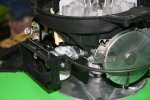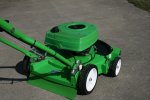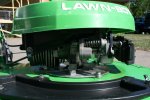FuzzyDriver
Well-Known Member
- Joined
- May 7, 2016
- Threads
- 13
- Messages
- 221
"How I Spent My 2020 Summer Vacation" by FuzzyDriver
Nothing on this mower was left as-is. This was not originally intended to be a museum display candidate, but it almost turned out that way during the three-month rebuild. Everything was torn down to individual components, inspected, cleaned, lubricated as necessary, painted as necessary, and reassembled using Lawn-Boy procedures and torque specifications, with the exception of the engine, which didn't need it.
The 7268 Aluminum deck didn't have any cracks or gouges so all I really had to do to it was brush it real good and repaint it. Automotive 'Grabber Green' works great. I put a NOS OEM 'Easy-Mulch' plate on (see photo at end) and couldn't see any color difference at all.
Compression checks showed that the original engine on this mower was OK, 95 psi (minimum is 80 psi), but, considering all the other work I was doing to 'new-ify' it, I wasn't going to settle for less than new specs (100-115 psi), so I replaced it with a newer engine I had on hand. The replacement engine is from a 7073. The 7073 compression was at the high-end of new engine specs, 115 psi, so I didn't see any need to mess with it. I figured the 7073 engine was so unused because the 7073 is a steel-deck - which doesn't last very long compared to the AL deck Lawn-Boys. Yeah, the deck that great engine was sitting on was awful, and I was happy to pitch it. Well, at least initially I thought the steel deck was the reason why the engine was like-new. It turned out there was ANOTHER reason they had stopped using it - but I'm getting ahead of myself (keep reading!) Note that the 7073 is a safety-mower, while the 7268 is pre-safety bale, so I had to use the 7073 handle assembly. Here's the 7073 engine sitting on the repainted 7268 deck:

During pre-teardown evaluation on the 7073, I found that the starter was filthy enough that sometimes it didn't return when you let the cord back in. When this happens, you can still pull the starter and it returns back, but it doesn't engage the flywheel. Obviously you can't start the engine when the starter assembly has this issue.
For those of you who need to work on their starter assembly, it is a bear to get off. You will probably have to remove the carburetor to get enough access to the set screw that holds it onto the engine. The set screw points down and is an allen-head. It was very tight. I ended up using a mirror to see it and an allen-head socket on a ratchet to turn it. I couldn't get an allen-wrench into it due to the narrow access angle. I painted the set screw red so at least now it's easy to see that bad boy, heh.
Once I got the starter assembly off, I completely disassembled it (including the return spring), cleaned, lubricated per specs, and put it back together with a new pull cord. I never messed with a Lawn-Boy spring itself before. The first time I put it back together, I had cleaned the spring, but not lubricated it.... So I took it back apart, lubricated it, and put it back together...backwards. 8^O The THIRD time I put it back together was the charm. If you've ever recoiled a spring back into the housing you know how much fun that is. Do it three times and it's Miller-time for sure.
I completely rebuilt the Walbro carburetor. Looks new and works like new. IMHO, switch your Lawn-Boy to a Walbro if you can (rather than the plastic carburetor).
Here's how the starter assembly and carburetor looked during install:


The muffler was good, but not good enough for me. So I cooked it on my propane camp stove. Lots of flame and black smoke. Once cooled, I brushed, cleaned, and painted it with VHT Flame-Proof exhaust system paint rated at 2,000 ºF. It looks better than new. It's a shame we have to turn our Lawn-Boys on their side to show off the muffler. ;^)

Since it's for sale, I got it an actual new OEM Lawn-Boy Tri-Cut blade. I can't show you the blade picture or me torquing it on because I've already attached 10 photos, which is the limit.
I got new after-market wheels and Rotary brand bolts for them. Original Lawn-Boy wheels have felt seals in recesses on the inside and outside of the wheel to keep crud from getting between the wheel bore and shoulder bolt. I think the purpose of these felts is to keep crud from getting in there and grinding away the plastic, causing rapid wear and wheel wobble.
The new wheels didn't have these recesses so I machined recesses in and put in new felt seals. I have a separate thread here on making a jig to fix this issue, if anyone is interested. I'm thinking about adding a pay-service to supply modded wheels/bolts, but I don't know if I would get enough customers to make it worthwhile.
Anyway, now the mower rolls as smooth as a new Lawn-Boy, and I expect the wheels to last a long time with those seals. :^)
Most of the photos show it with a new deck plate. Why are new plates black?? I have one picture of the mower with the original (brushed clean) plate. I also took a picture with the NOS 'Easy-Mulch' plate for comparison. Compare them - you can see how much the original plate is faded.
So what makes me think the steel deck isn't the only reason the mower prematurely stopped getting used? When I had the mower COMPLETELY finished and ready for first start....I put fuel in the tank, and it dribbled slowly out of a crack onto my *new* mower... Aaarrrgh!!! A previous owner had apparently wacked the shroud hard enough against something to crack it. This is also probably why the starter mechanism was so filthy (dried pre-mix oil), but I didn't put two-and-two together then.
Once I replaced the shroud (with a tank that doesn't leak!) the mower was all ready. It runs great and looks like new!






TL; DR: I turned a 1978 Lawn-Boy 7268 into a brand-new resto-modded mower that anyone would be proud to own.
Nothing on this mower was left as-is. This was not originally intended to be a museum display candidate, but it almost turned out that way during the three-month rebuild. Everything was torn down to individual components, inspected, cleaned, lubricated as necessary, painted as necessary, and reassembled using Lawn-Boy procedures and torque specifications, with the exception of the engine, which didn't need it.
The 7268 Aluminum deck didn't have any cracks or gouges so all I really had to do to it was brush it real good and repaint it. Automotive 'Grabber Green' works great. I put a NOS OEM 'Easy-Mulch' plate on (see photo at end) and couldn't see any color difference at all.
Compression checks showed that the original engine on this mower was OK, 95 psi (minimum is 80 psi), but, considering all the other work I was doing to 'new-ify' it, I wasn't going to settle for less than new specs (100-115 psi), so I replaced it with a newer engine I had on hand. The replacement engine is from a 7073. The 7073 compression was at the high-end of new engine specs, 115 psi, so I didn't see any need to mess with it. I figured the 7073 engine was so unused because the 7073 is a steel-deck - which doesn't last very long compared to the AL deck Lawn-Boys. Yeah, the deck that great engine was sitting on was awful, and I was happy to pitch it. Well, at least initially I thought the steel deck was the reason why the engine was like-new. It turned out there was ANOTHER reason they had stopped using it - but I'm getting ahead of myself (keep reading!) Note that the 7073 is a safety-mower, while the 7268 is pre-safety bale, so I had to use the 7073 handle assembly. Here's the 7073 engine sitting on the repainted 7268 deck:

During pre-teardown evaluation on the 7073, I found that the starter was filthy enough that sometimes it didn't return when you let the cord back in. When this happens, you can still pull the starter and it returns back, but it doesn't engage the flywheel. Obviously you can't start the engine when the starter assembly has this issue.
For those of you who need to work on their starter assembly, it is a bear to get off. You will probably have to remove the carburetor to get enough access to the set screw that holds it onto the engine. The set screw points down and is an allen-head. It was very tight. I ended up using a mirror to see it and an allen-head socket on a ratchet to turn it. I couldn't get an allen-wrench into it due to the narrow access angle. I painted the set screw red so at least now it's easy to see that bad boy, heh.
Once I got the starter assembly off, I completely disassembled it (including the return spring), cleaned, lubricated per specs, and put it back together with a new pull cord. I never messed with a Lawn-Boy spring itself before. The first time I put it back together, I had cleaned the spring, but not lubricated it.... So I took it back apart, lubricated it, and put it back together...backwards. 8^O The THIRD time I put it back together was the charm. If you've ever recoiled a spring back into the housing you know how much fun that is. Do it three times and it's Miller-time for sure.
I completely rebuilt the Walbro carburetor. Looks new and works like new. IMHO, switch your Lawn-Boy to a Walbro if you can (rather than the plastic carburetor).
Here's how the starter assembly and carburetor looked during install:


The muffler was good, but not good enough for me. So I cooked it on my propane camp stove. Lots of flame and black smoke. Once cooled, I brushed, cleaned, and painted it with VHT Flame-Proof exhaust system paint rated at 2,000 ºF. It looks better than new. It's a shame we have to turn our Lawn-Boys on their side to show off the muffler. ;^)

Since it's for sale, I got it an actual new OEM Lawn-Boy Tri-Cut blade. I can't show you the blade picture or me torquing it on because I've already attached 10 photos, which is the limit.
I got new after-market wheels and Rotary brand bolts for them. Original Lawn-Boy wheels have felt seals in recesses on the inside and outside of the wheel to keep crud from getting between the wheel bore and shoulder bolt. I think the purpose of these felts is to keep crud from getting in there and grinding away the plastic, causing rapid wear and wheel wobble.
The new wheels didn't have these recesses so I machined recesses in and put in new felt seals. I have a separate thread here on making a jig to fix this issue, if anyone is interested. I'm thinking about adding a pay-service to supply modded wheels/bolts, but I don't know if I would get enough customers to make it worthwhile.
Anyway, now the mower rolls as smooth as a new Lawn-Boy, and I expect the wheels to last a long time with those seals. :^)
Most of the photos show it with a new deck plate. Why are new plates black?? I have one picture of the mower with the original (brushed clean) plate. I also took a picture with the NOS 'Easy-Mulch' plate for comparison. Compare them - you can see how much the original plate is faded.
So what makes me think the steel deck isn't the only reason the mower prematurely stopped getting used? When I had the mower COMPLETELY finished and ready for first start....I put fuel in the tank, and it dribbled slowly out of a crack onto my *new* mower... Aaarrrgh!!! A previous owner had apparently wacked the shroud hard enough against something to crack it. This is also probably why the starter mechanism was so filthy (dried pre-mix oil), but I didn't put two-and-two together then.
Once I replaced the shroud (with a tank that doesn't leak!) the mower was all ready. It runs great and looks like new!






TL; DR: I turned a 1978 Lawn-Boy 7268 into a brand-new resto-modded mower that anyone would be proud to own.

